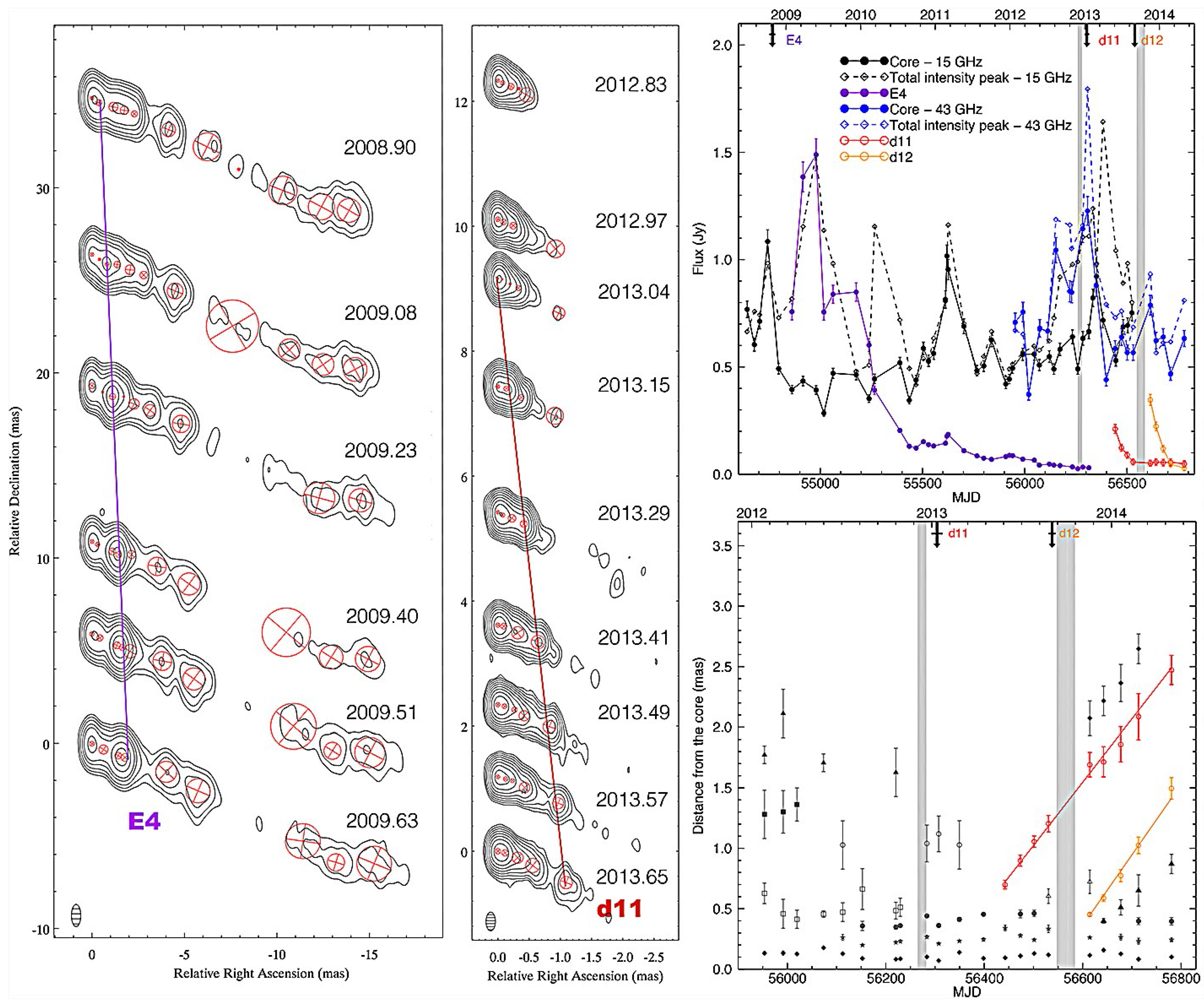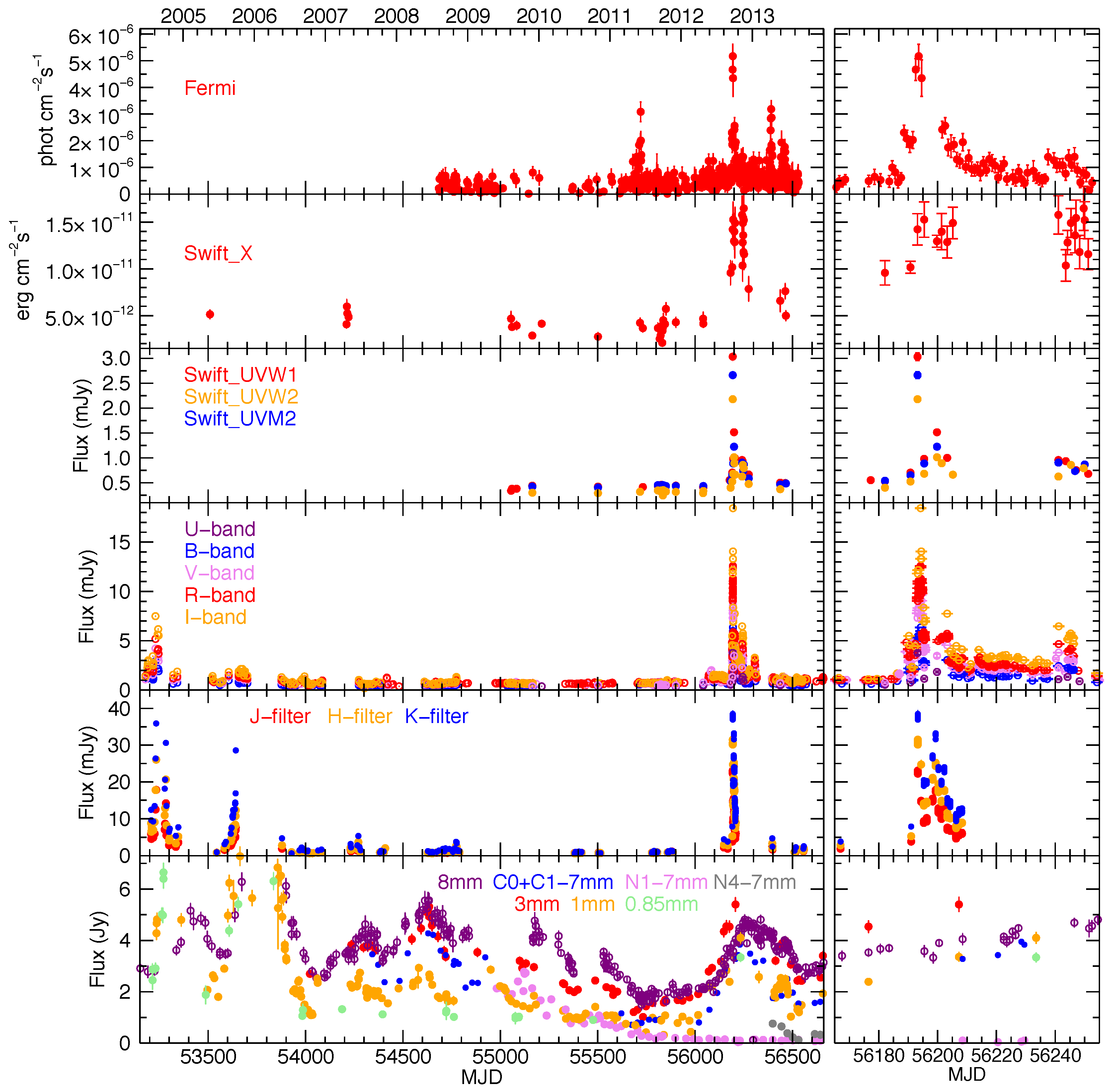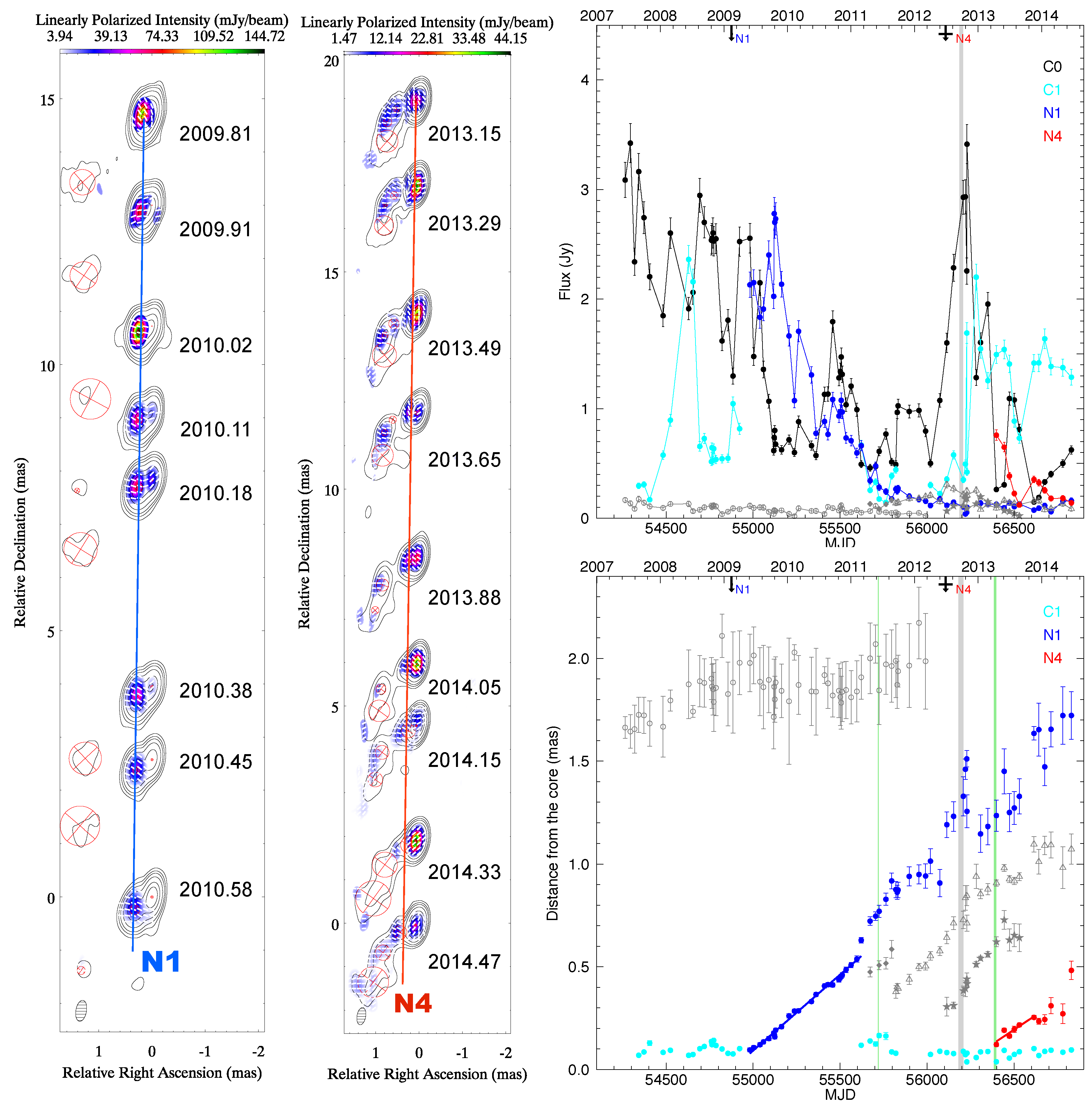The Connection between the Radio Jet and the γ-ray Emission in the Radio Galaxy 3C 120 and the Blazar CTA 102
Abstract
:1. Introduction
2. Observations and Data Reduction
2.1. The VLBA Data Analysis
2.2. The Fermi Data Analysis
2.3. CTA 102 Multi-Wavelength Analysis
3. Results
3.1. The Radio Galaxy 3C 120
3.2. The Blazar CTA 102
4. Conclusions
Conflicts of Interest
References
- Tanaka, Y.T.; Cutini, S.; Ciprini, S.; Cheung, C.C.; Buehler, R.; Kocevski, D. Fermi LAT Detection of Gamma-ray Flaring Activity from Broad Line Radio Galaxy 3C 120. Available online: http://www.astronomerstelegram.org/?read=6529 (accessed on 14 September 2016).
- Acero, F.; Collaboration, F.-L. Fermi Large Area Telescope Third Source Catalog. Astrophys. J. Suppl. Ser. 2015, 218, 23. [Google Scholar] [CrossRef]
- Ciprini, S. Fermi LAT Detection of a GeV Flare from Blazar CTA 102. Available online: http://www.astronomerstelegram.org/?read=8478 (accessed on 14 September 2016).
- Orienti, M.; D’Ammando, F. Fermi LAT Detection of a Continuing Increase of Gamma-ray Activity of CTA 102. Available online: http://www.astronomerstelegram.org/?read=4409 (accessed on 14 September 2016).
- Larionov, V.; Blinov, D.; Jorstad, S. An Unprecedented Optical Outburst of the Blazar CTA102. Available online: http://www.astronomerstelegram.org/?read=4397 (accessed on 14 September 2016).
- Carrasco, L.; Luna, A.; Porras, A.; Mayya, D.Y. NIR Brightening of the Blazar CTA102. Available online: http://www.astronomerstelegram.org/?read=4442 (accessed on 14 September 2016).
- Casadio, C.; Gómez, J.L.; Grandi, P.; Jorstad, S.G.; Marscher, A.P.; Lister, M.L.; Kovalev, Y.Y.; Savolainen, T.; Ushkarev, A.B. The Connection between the Radio Jet and the Gamma-ray Emission in the Radio Galaxy 3C 120. Astrophys. J. 2015, 808, 162. [Google Scholar] [CrossRef]
- Casadio, C.; Gómez, J.L.; Jorstad, S.G.; Marscher, A.P.; Larionov, V.M.; Smith, P.S.; Gurwell, M.A.; Lähteenmäki, A.; Agudo, I.; Molina, S.N.; et al. A Multi-wavelength Polarimetric Study of the Blazar CTA 102 during a Gamma-Ray Flare in 2012. Astrophys. J. 2015, 813, 51. [Google Scholar] [CrossRef]
- Lister, M.L.; Cohen, M.H.; Homan, D.C.; Kadler, M.; Kellermann, K.I.; Kovalev, Y.Y.; Ros, E.; Savolainen, T.; Zensus, J.A. MOJAVE: Monitoring of Jets in Active Galactic Nuclei with VLBA Experiments. VI. Kinematics Analysis of a Complete Sample of Blazar Jets. Astrophys. J. 2009, 138, 1874–1892. [Google Scholar] [CrossRef]
- Jorstad, S.G.; Marscher, A.P.; Lister, M.L.; Stirling, A.M.; Cawthorne, T.V.; Gear, W.K.; Gomez, J.L.; Stevens, J.A.; Smith, P.S.; Forster, J.R.; et al. Polarimetric Observations of 15 Active Galactic Nuclei at High Frequencies: Jet Kinematics from Bimonthly Monitoring with the Very Long Baseline Array. Astrophys. J. 2005, 130, 1418–1465. [Google Scholar] [CrossRef]
- Marscher, A.P.; Gear, W.K. Models for high-frequency radio outbursts in extragalactic sources, with application to the early 1983 millimeter-to-infrared flare of 3C 273. Astrophys. J. 1985, 298, 114–127. [Google Scholar] [CrossRef]
- Caproni, A.; Abraham, Z. Can long-term periodic variability and jet helicity in 3C 120 be explained by jet precession? Mon. Not. R. Astron. Soc. 2004, 349, 1218–1226. [Google Scholar] [CrossRef]
- Janiak, M.; Sikora, M.; Moderski, R. Application of the spine-layer jet radiation model to outbursts in the broad-line radio galaxy 3C 120. Mon. Not. R. Astron. Soc. 2016, 458, 2360–2370. [Google Scholar] [CrossRef]
- Jorstad, S.G.; Marscher, A.P.; Smith, P.S.; Larionov, V.M.; Agudo, I.; Gurwell, M.; Wehrle, A.E.; Lähteenmäki, A.; Nikolashvili, M.G.; Schmidt, G.D.; et al. A Tight Connection between Gamma-Ray Outbursts and Parsec-scale Jet Activity in the Quasar 3C 454.3. Astrophys. J. 2013, 773, 147. [Google Scholar] [CrossRef]
- Marscher, A.P.; Jorstad, S.G.; Gómez, J.L.; Aller, M.A.; Teräsranta, H.; Lister, M.L.; Stirling, A.M. Observational evidence for the accretion-disk origin for a radio jet in an active galaxy. Nature 2002, 417, 625–627. [Google Scholar] [CrossRef] [PubMed]
- Fromm, C.M.; Perucho, M.; Ros, E.; Savolainen, T.; Zensus, J.A. On the location of the supermassive black hole in CTA 102. Astron. Astrophys. 2015, 576, A43. [Google Scholar] [CrossRef]



| MJD | Date | Flux | Err | TS |
|---|---|---|---|---|
| 56264−56279 | 3 December–18 December 2012 | 1.41 | 0.60 | 10.6 |
| 56549−56564 | 14 September–29 September 2013 | 1.65 | 0.54 | 21.6 |
| 56564−56579 | 29 September–14 October 2013 | 1.31 | 0.53 | 13.3 |
| 56774−56789 | 27 April–12 May 2014 | 1.15 | 0.52 | 10.4 |
| 56819−56834 | 11 June–26 June 2014 | 1.47 | 0.59 | 13.8 |
| 56924−56939 | 24 September–9 October 2014 | 2.52 | 0.86 | 18.4 |
© 2016 by the authors; licensee MDPI, Basel, Switzerland. This article is an open access article distributed under the terms and conditions of the Creative Commons Attribution (CC-BY) license (http://creativecommons.org/licenses/by/4.0/).
Share and Cite
Casadio, C.; Gómez, J.L.; Jorstad, S.G.; Marscher, A.P.; Grandi, P.; Larionov, V.M.; Lister, M.L.; Smith, P.S.; Gurwell, M.A.; Lähteenmäki, A.; et al. The Connection between the Radio Jet and the γ-ray Emission in the Radio Galaxy 3C 120 and the Blazar CTA 102. Galaxies 2016, 4, 34. https://doi.org/10.3390/galaxies4040034
Casadio C, Gómez JL, Jorstad SG, Marscher AP, Grandi P, Larionov VM, Lister ML, Smith PS, Gurwell MA, Lähteenmäki A, et al. The Connection between the Radio Jet and the γ-ray Emission in the Radio Galaxy 3C 120 and the Blazar CTA 102. Galaxies. 2016; 4(4):34. https://doi.org/10.3390/galaxies4040034
Chicago/Turabian StyleCasadio, Carolina, José L. Gómez, Svetlana G. Jorstad, Alan P. Marscher, Paola Grandi, Valeri M. Larionov, Matthew L. Lister, Paul S. Smith, Mark A. Gurwell, Anne Lähteenmäki, and et al. 2016. "The Connection between the Radio Jet and the γ-ray Emission in the Radio Galaxy 3C 120 and the Blazar CTA 102" Galaxies 4, no. 4: 34. https://doi.org/10.3390/galaxies4040034







